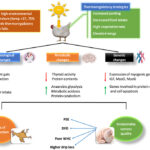Producing a successful research thesis or dissertation involves several critical stages—from writing a synopsis and recording data, to analyzing results and finally publishing findings. Each stage must be approached with precision, clarity, and adherence to academic standards.
1. Synopsis and Thesis Writing: Formats and Contents
a. Synopsis Writing
A synopsis is a concise summary of the proposed research work submitted before the actual thesis. It demonstrates the researcher’s understanding of the topic, the rationale, and the planned methodology.
Typical Format of a Synopsis:
- Title: Clear, concise, and specific.
- Introduction: Background information and context of the study.
- Problem Statement: A brief explanation of the research problem and its significance.
- Objectives: Clear, measurable objectives or hypotheses.
- Literature Review: Summary of past work and identification of research gaps.
- Research Methodology:
- Study design
- Sample size and sampling technique
- Tools and instruments
- Data collection procedures
- Expected Outcomes: Anticipated results and potential applications.
- Timeline: Schedule of activities.
- References: Preliminary bibliography.
b. Thesis Writing
A thesis is a comprehensive document that presents the research process and findings in detail.
Standard Thesis Format:
- Preliminary Pages:
- Title Page
- Declaration/Certificate
- Acknowledgements
- Abstract
- Table of Contents
- List of Tables and Figures
- Chapter 1: Introduction
- Background
- Problem Statement
- Objectives and Hypotheses
- Justification and Significance
- Chapter 2: Literature Review
- Critical review of related studies
- Identification of knowledge gaps
- Chapter 3: Materials and Methods
- Research design
- Experimental setup
- Sampling and data collection methods
- Statistical tools used for analysis
- Chapter 4: Results and Discussion
- Presentation of analyzed data
- Tables, graphs, and charts
- Interpretation and comparison with previous findings
- Chapter 5: Conclusion and Recommendations
- Summary of key findings
- Implications
- Suggestions for future research
- References: Properly formatted bibliography (APA, MLA, Harvard, etc.)
- Appendices: Supplementary data, questionnaires, raw data, etc.
2. Recording Experimental Data and Its Subsequent Analysis Using Appropriate Statistical Software
a. Recording Experimental Data
Accurate data recording is crucial for ensuring the reliability and reproducibility of results.
Best Practices:
- Use standardized data sheets or logbooks.
- Maintain date-wise entries with units and measurement tools.
- Record observations immediately to avoid memory errors.
- Ensure data integrity by avoiding overwriting or erasing entries.
- Store data both manually and digitally for backup.
b. Statistical Analysis of Data
Statistical analysis helps transform raw data into meaningful insights and conclusions.
Commonly Used Statistical Software:
- SPSS (Statistical Package for the Social Sciences): User-friendly interface for basic and advanced statistical analysis.
- R: Powerful open-source software used for statistical computing and graphics.
- SAS: Widely used in research institutions for advanced analytics.
- GraphPad Prism: Common in biological sciences for analyzing and visualizing data.
- Minitab: Suitable for industrial and quality control studies.
- Excel: Basic statistical tools, suitable for simple analyses.
Basic Statistical Tests:
- Descriptive statistics (mean, median, mode, standard deviation)
- t-tests (paired and unpaired)
- ANOVA (Analysis of Variance)
- Chi-square test
- Correlation and Regression analysis
- Non-parametric tests (Mann–Whitney, Kruskal–Wallis)
The choice of statistical test depends on:
- Type of data (qualitative or quantitative)
- Number of groups being compared
- Distribution (normal or skewed)
3. Publishing Research Results
Publishing is the final step in the research process and crucial for disseminating findings to the scientific community.
a. Choosing the Right Journal
- Select journals that align with your research area.
- Check impact factor, scope, indexing, and acceptance rate.
- Read the author guidelines carefully.
b. Manuscript Structure
- Title: Brief and informative.
- Abstract: Summary of the study (usually structured into background, methods, results, conclusion).
- Keywords: 4–6 relevant words for indexing.
- Introduction: Context, problem, and objectives.
- Materials and Methods: Detailed description for reproducibility.
- Results: Objective presentation of data with tables and figures.
- Discussion: Interpretation, comparison with previous work, implications.
- Conclusion: Summary and potential applications.
- References: Cited in appropriate format.
- Acknowledgments, if applicable.
c. Types of Publications
- Original Research Article
- Review Article
- Short Communication
- Case Study (for clinical/medical fields)
- Conference Abstracts and Proceedings
d. Ethical Considerations
- Avoid plagiarism and data fabrication.
- Disclose conflicts of interest.
- Obtain informed consent (for human subjects).
- Comply with journal ethical guidelines (e.g., COPE standards).
Conclusion
Producing and publishing quality research requires a structured approach from synopsis writing to data analysis and manuscript preparation. Adhering to standard formats, maintaining accuracy in data recording, using suitable statistical methods, and choosing the right publication platform all contribute to the success and impact of research work. A well-documented and analyzed study not only enhances the credibility of the researcher but also contributes meaningfully to scientific advancement.





Very informative
Wonderful
Nice and easy to understand